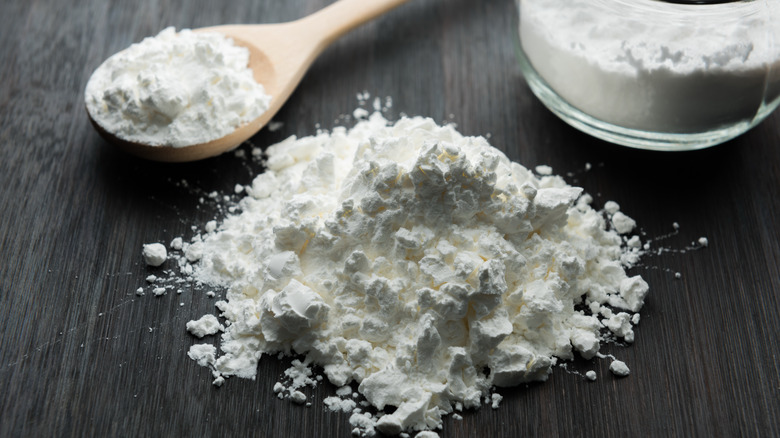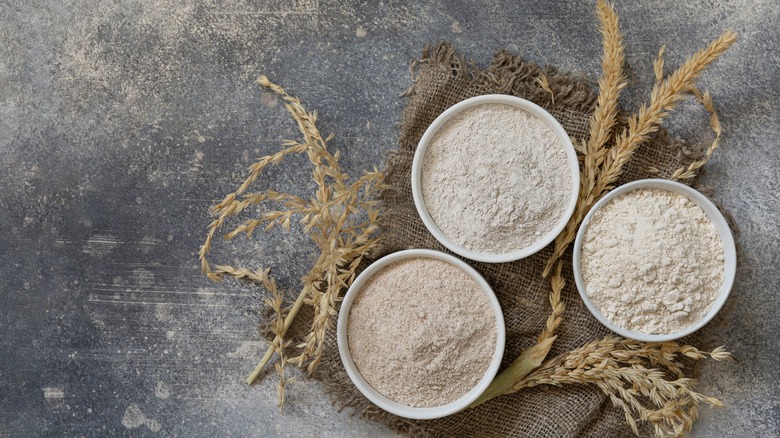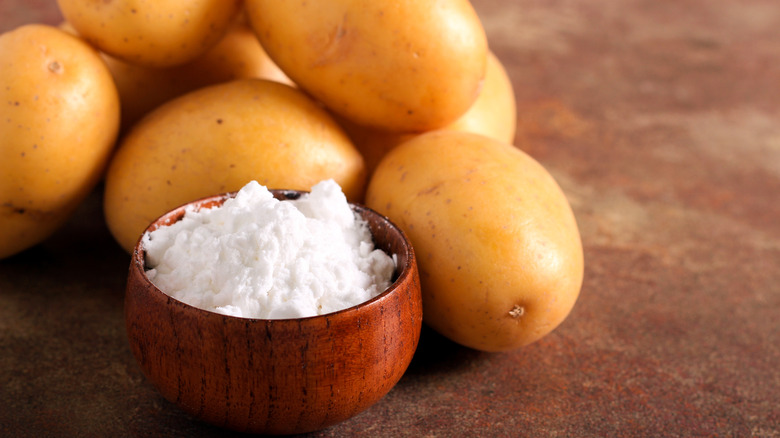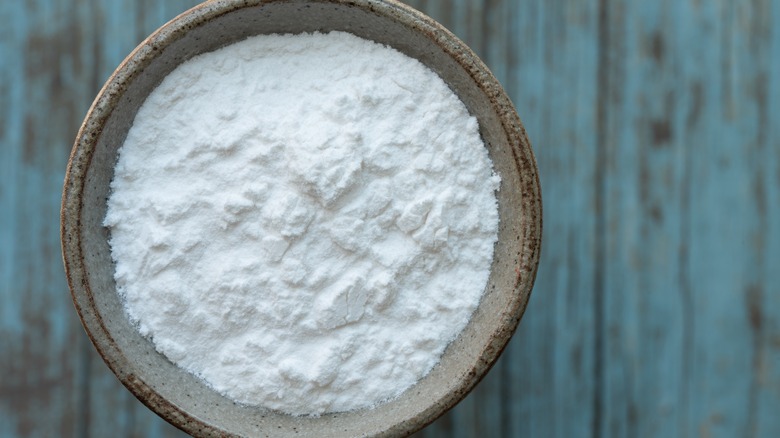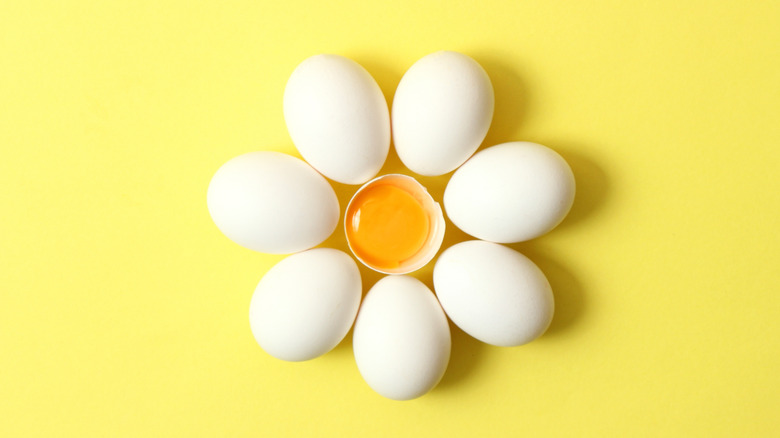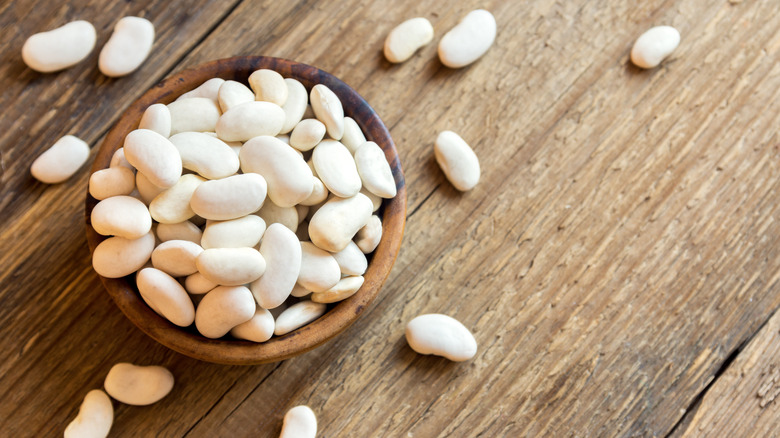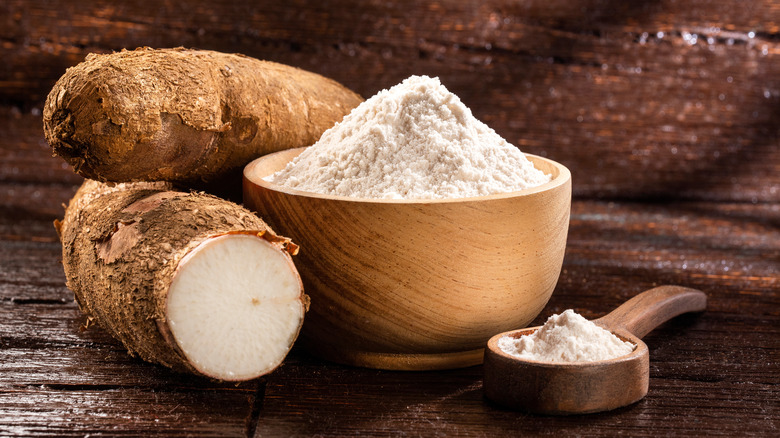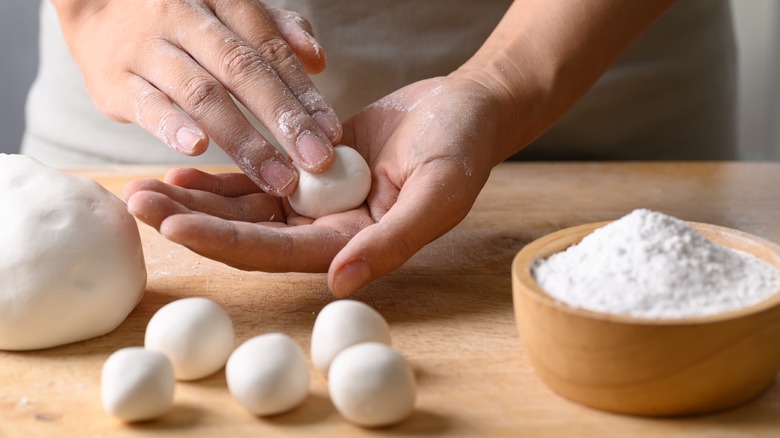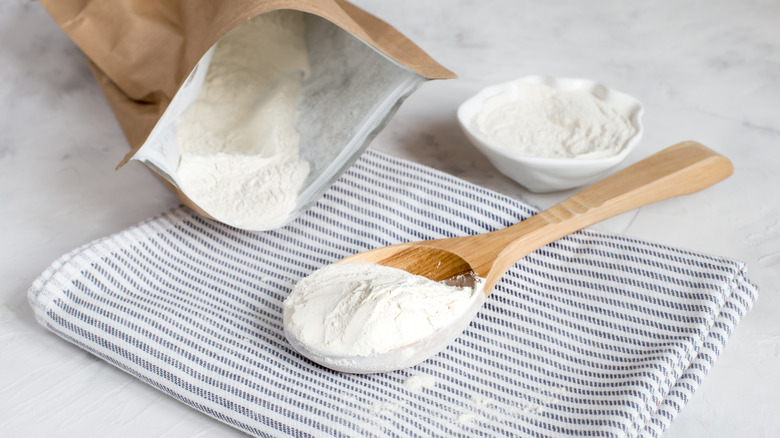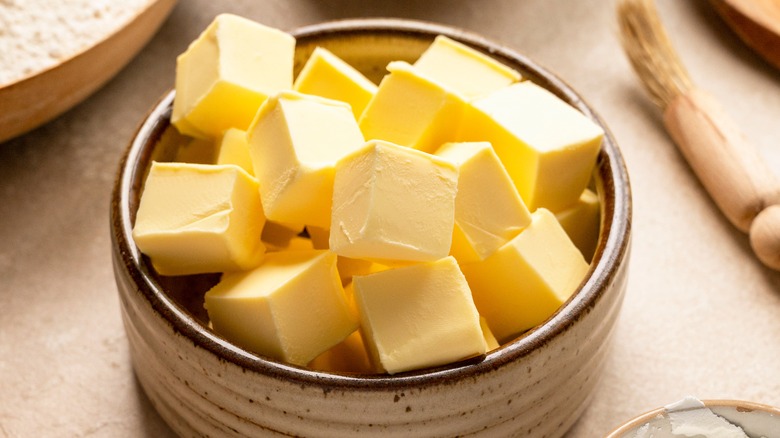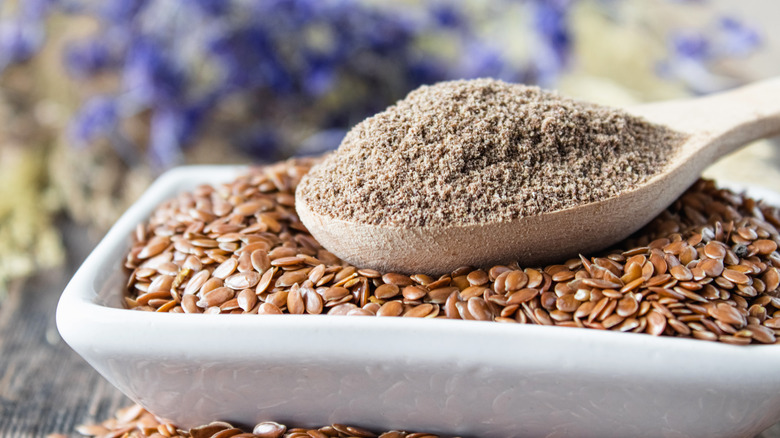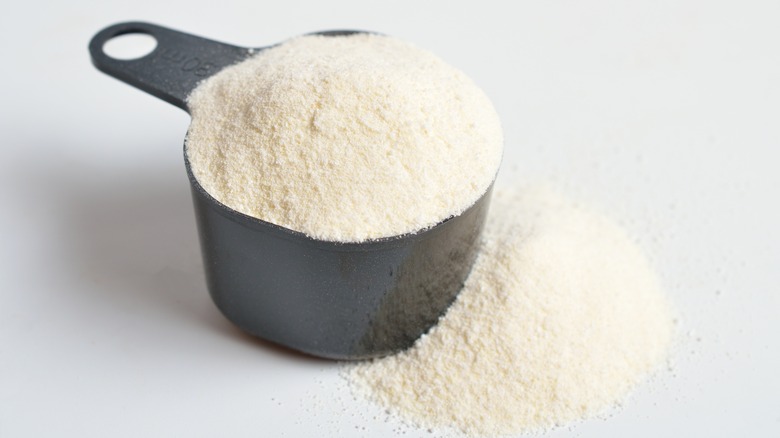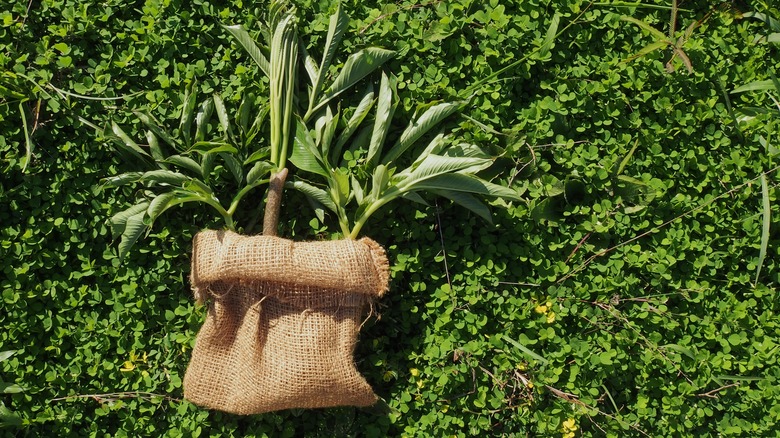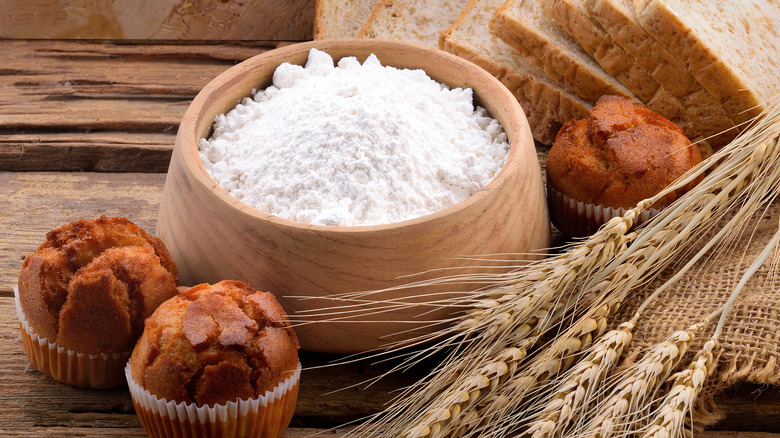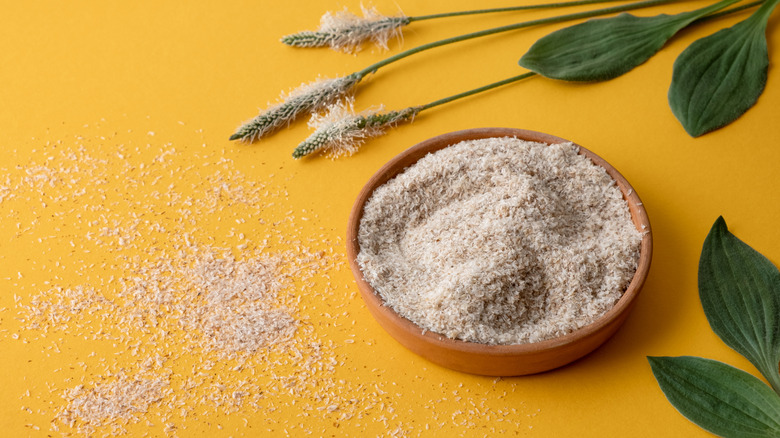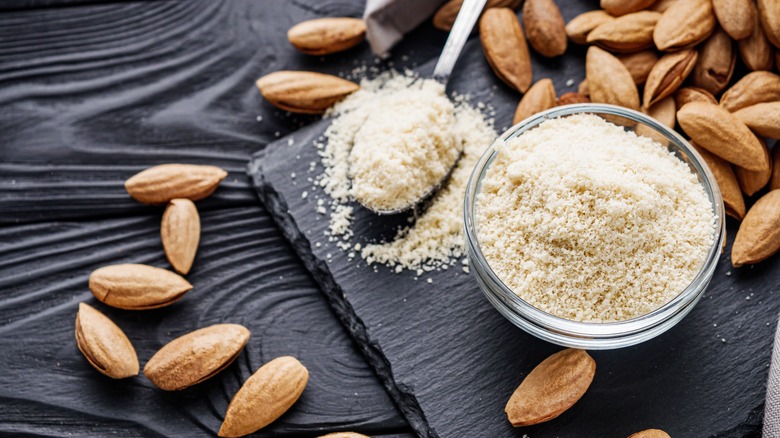15 Effective Substitutes For Cornstarch
Don't underestimate the power of cornstarch. This unassuming-looking and neutral-tasting white powder, which at first glance could be mistaken for flour, is an incredibly effective thickening agent used in a wide range of foods, everything from sauces to cookie batters. Cornstarch is derived from bright yellow corn by processing the endosperm — the bit just under the skin — of the kernels themselves, explains registered dietitian and "The Clean & Simple Diabetes Cookbook" author Jackie Newgent via Women's Health Magazine. The resultant powder brings a velvety texture to foods we know and love.
But this ingredient is far from universally loved. For some folks, cornstarch can be a problematic ingredient. Corn allergies, while rare, can trigger potential allergic responses in some individuals, with cornstarch and other corn products creating symptoms like wheezing, hives, gastrointestinal issues, and occasionally, anaphylaxis (per Healthline). And other people might just be a little bit tired of using the same thickening agent day in and day out, and are looking for some new ways to bulk out their meals. Well, truth be told, there are a lot of ways you can thicken food without using cornstarch. And we decided to put them all in one place for you.
1. Wheat flour
If you're trying to avoid cornstarch (or have simply run low on your supplies) and you're trying to emulate its thickening power, wheat flour may be a great substitute. Wheat flour thickens sauces and stews for the same reason that cornstarch works for this purpose — it's high starch content. When starch molecules come into contact with heat, they expand, burst, and combine with the water in a dish, and the successful blending of the two results in a thicker, lump-free sauce, explains BBC Science Focus.
It's important not to just throw your flour in and hope for the best, though. For the smoothest results, mix your flour with a little bit of cold water beforehand, and pour it slowly into whatever you're making while stirring constantly. Ensure you're not doing this just before you finish cooking, as the flour needs to heat up to both thicken the food properly and so you don't get any of that raw flour taste. Bear in mind, too, that while wheat flour can thicken sauces capably, you'll need to add more than if you were using cornstarch –- around double the amount.
2. Potato starch
With cornstarch's popularity as a thickening agent, it's easy to forget about potato starch. But if you're looking for a cornstarch substitute, look no further. Potato starch can be used in most situations that call for cornstarch without any significant changes to the finished food, as Bob's Red Mill explains. This powder is an especially good substitute for meals that call for higher temperatures, as it's a little stronger than cornstarch and holds up better, although food that's too hot will stop the potato starch from thickening it effectively. And before you ask, no, it doesn't taste like potato and is pretty much flavorless (via Dr. Axe).
Potato starch is also an excellent way to thicken sauces and stews without cornstarch while remaining gluten-free, and quality potato starch will often be formulated to be accessible for individuals with other food allergies as well (per Bob's Red Mill). Crucially, though, while potato starch is robust at hotter temperatures, extended cooking times can cause it to break down, so try to avoid its use in meals that take an especially long time to prepare. As they work similarly, you don't have to make any significant adjustments to the ratio when using potato starch: You can add in the same amount as you would cornstarch, states Healthline.
3. Arrowroot
You may not be as familiar with arrowroot as you are with cornstarch, but trust us when we tell you it's a great choice for your food. Created by drying and grinding Maranta arundinacea tubers, arrowroot is a neutral-tasting, odorless white starch, and can be used in pretty much the same way as cornstarch. Arrowroot is a particularly good substitute in spreads like jam or marmalade, as these have a higher acidity, which arrowroot is more equipped to handle without breaking down. And it's pretty much a straight swap for cornstarch amount-wise, so no complicated measurements are required.
Like cornstarch, when you're adding arrowroot into food, ensure that you're mixing it with a little water first to ensure that it doesn't create lumps and thicken ineffectively. Where arrowroot may be less successful than cornstarch is if you're using it at higher temperatures, as this can cause the starch to lose its structure, as Masterclass explains. For this reason, you should try and add arrowroot toward the end of your cooking process. Remember, this starch doesn't need to boil to get thicker, so don't be shy about throwing it in just after you take your food off the heat.
4. Egg yolks
Although it's common to replace a powder-based thickening agent with another powder-based thickening agent, there are plenty of other ways to add substance to a dish. And one of these is by using good old-fashioned egg yolks. Using egg yolks is a particularly good way of thickening sauces, stews, or soups without boosting their carbohydrate content, and their high-fat, low-carb nature makes them an ideal choice for people following the keto diet (via Mark's Daily Apple). You'll also give your food a good boost of protein, amp up your vitamin and mineral content, and give your food an even richer flavor (per Medical News Today). Those are all positives in our book, folks.
When using egg yolks to thicken food, though, your technique is everything. Simply dumping your egg yolks straight into the hot pot will leave you with cooked lumps of egg. Instead, reduce your heat slightly, take a little of your cooking liquid out, and add it to your beaten egg yolks. Once the mixture has come up in temperature, slowly pour it into your cooking pot on low heat, stirring it in. Continue until all of the egg mixture is incorporated. It can be useful to do this towards the end of the cooking process so that your eggs don't have a chance to cook.
5. Beans
Cornstarch is a pantry staple. But another pantry staple may help you add bulk to your food while also giving it a serious nutritional boost. "Depending on the recipe, you may be able to achieve a thickening effect by simply pureeing in plant-based ingredients," states "The Clean & Simple Diabetes Cookbook" author and registered dietitian Jackie Newgent to Women's Health Magazine. One such ingredient that could be useful, says Newgent, is white beans, which can be blitzed and thrown into an array of sauces.
One of the best things about using white beans to thicken food is their protein content. By throwing half a cup of pureed cooked white beans into your sauce or stew, you'll give it eight additional grams of protein, according to My Food Data. The added fiber content you'll get is also exceptional, with over nine grams of fiber per half-cup of cooked small white beans. The additional protein and fiber will not only fill out your dish but fill you up too, with both nutrients helping to increase satiety, according to research published in Trends in Food Science & Technology. Remember, though, that beans don't have as neutral of a flavor as cornstarch or other powdered starches, and so if you add them, you may well taste them.
6. Tapioca
If you're looking for a cornstarch replacement, look no further than tapioca. Although you may be more familiar with tapioca in its ball form, bobbing luxuriantly at the bottom of a bubble tea, it also comes in a cornstarch-like powder. Like other starches on the market, tapioca is created by processing a plant (in this case, the root of the cassava plant) into fine flour. The powder that comes out the other end works much like cornstarch in its thickening capabilities and can be substituted pretty seamlessly (per Healthline).
Coming from the cassava root, tapioca is naturally gluten-free, and can be a great replacement for cornstarch for people who have a gluten intolerance or celiac disease. While it's commonly added to sweeter dishes like puddings, thanks to its fairly neutral flavor, it can be used in pretty much anything you care to throw it into (although you might find that tapioca does have some subtly sweet undertones, as From The Larder explains). Tapioca can also give your meals a certain luster and shine that other starches may not. Importantly, though, the amounts that you'll need to use are slightly different. For each tablespoon of cornstarch a recipe calls for, you'll need two tablespoons of tapioca starch.
7. Rice flour
Most of us are way more familiar with rice as a grain than in its flour form. But people looking to replace cornstarch would be wise to pick up a bag of rice flour at the store. Like the grain, rice flour comes in white and brown varieties, with glutinous rice flour also available. The qualities of a given rice flour will be similar to the grain when cooked. Brown rice flour, for example, will have a little more bite to it, thanks to being milled using whole rice grain, while white rice flour will be smoother and more starchy, and glutinous rice flour is much chewier (via Masterclass).
All of them, though, can be used as thickening agents, with white rice flour also being a great choice to make batters that call for cornstarch. Glutinous rice flour can be a particularly good addition to cakes and desserts, giving them a candy-like consistency (if you've ever tried mochi, you've tried glutinous rice flour). One of the best things about rice flour, too, is that, unlike other starches, you can sprinkle it dry straight into your food to start the thickening process. Just make sure you add it slowly, a little at a time, to avoid making your food too thick.
8. Xanthan gum
While you may not have cooked with xanthan gum before, you've probably come across it. The powder, created as a byproduct of fermenting foods with the Xanthomonas campestris bacteria, is a common additive to store-bought desserts and dressings, giving them additional bulk. It's also frequently found in non-food items like cosmetic products (per BBC Good Food).
But just because you may not have used it in your kitchen doesn't mean you should write it off. When used correctly, xanthan gum is an excellent substitute for cornstarch and can be used in a lot of situations that call for the corn-derived ingredient. It could also be an addition to your food that has come gastrointestinal benefits, as in some cases it may help your body move food through the gut with greater ease, encouraging healthy digestion.
Xanthan gum is handy for baking recipes and can serve to give bulk and cohesion to a host of baked goods. If you're adding it to a liquid-heavy meal to thicken it up, though, it's important to go slow and just add a little bit at a time. Even adding a bit too much can cause your cooking liquid to gain too much bulk and take on a paste-like consistency.
9. Butter
You may be more used to adding butter to your food to give it a richer flavor (which we, of course, heartily approve of). But putting a pat of butter in meals doesn't just give them an added taste. Placing butter in food toward the end of a cooking process, especially for sauces or stews, can have a binding effect, with the fats in the butter reacting with the other elements in a dish to thicken things slightly. And as a bonus, your food will take on an enviable gloss.
Butter is an especially good choice for people who are looking to keep the carb amount in their food low, and unlike powdered starches, it will add primarily fat and not carbohydrates. To use butter to maximum effect, though, you need to time it right. Use a cold knob of solid butter, not butter that's been already melted, as Pure Wow explains, and only add it once your food is off the heat and almost ready to serve. The aim is not to melt the butter rapidly, which will cause it to split and the fats to separate. By melting the cold butter slowly, the fats will incorporate effectively, giving your food the thickness you need.
10. Ground flaxseeds
Flaxseeds are pretty much always a good addition to food on the nutrition front. Rich in omega-3 and fiber, these potent little seeds can provide a powerful health boost, as WebMD explains. But on a pure culinary level, there's one key reason to add flaxseeds, which is their thickening capabilities. Ground flaxseeds, in particular, are excellent substitutes for cornstarch, as when you add them to a meal, they absorb water quickly and form a gum-like mass that can then be evenly distributed through the food (via Healthline). The mass is provided by their fiber, making them a great way to boost your daily fiber intake.
However, it's worth noting that using fiber instead of starch to thicken a meal will result in it having a different consistency, with ground flaxseed being a little mealier. Additionally, ground flaxseed has a gentle nuttiness to its flavor that might slightly alter the taste of your food. Make sure that you take this into account when adding it to meals, potentially by altering seasonings elsewhere to ensure the flaxseed doesn't become a dominant flavor.
11. Guar gum
Guar gum may sound like it's been beamed down from space, but this entirely earth-bound ingredient is only out of this world in one sense: The way it can act as a cornstarch substitute. Made by processing and grinding guar beans into a fine powder, according to the International Food Additives Council, guar gum is an excellent gluten-free addition to food, and like xanthan gum can be used effectively in gluten-free bakes, as well as sauces and soups. Unlike cornstarch, guar gum thickens things up through its soluble fiber content, and adding it to food can bring you a few health bonuses, such as a boost to your digestive system and gut bacteria, and the potential to help control blood sugar (via Healthline).
One particular perk of using guar gum to thicken food is that where other starch-based additives can lose their structure at high temperatures, resulting in your sauces remaining just as thin, guar gum stays stable. As such, you can add it to recipes during cooking. Bear in mind, though, that guar gum is pretty powerful as a thickening agent, so only use a little bit at first, and add more if you need to.
12. Glucomannan
If you haven't cooked with glucomannan before, we wouldn't judge you for it. This lesser-known ingredient is not nearly as popular as cornstarch when it comes to thickening agents, but rest assured that it's just as powerful. Similar to guar gum, glucomannan is a product that gets its thickening capacities from soluble fiber content, derived from the konjac plant. When soluble fiber comes into contact with water, it turns into a gel and creates bulk, as Mount Sinai explains. When this happens in our digestive system, it helps to keep us full, but when it's put into food, we cut out the middleman of our stomach and add volume then and there.
Glucomannan has no carbohydrates at all, and as such, using it instead of cornstarch can be a good choice for people following a keto diet (per Healthline). The high dose of fiber you're adding to your meal could also bring benefits to your gut health and bacteria. Crucially, though, the consistency will be slightly different than if using cornstarch, with glucomannan taking on a gel-like composition -– so bear in mind that if you're after the velvety texture of cornstarch, glucomannan may not be a like-for-like swap. As with other fiber-based thickening agents, it's crucial to use it sparingly.
13. All-purpose flour
There are some cornstarch alternatives out there that might be harder to find, but we can pretty much guarantee you won't have trouble finding all-purpose flour. As cornstarch substitutes go, all-purpose flour is one of the easiest to use and operates pretty much identically to wheat flour or other flour varieties. One of the bonuses of all-purpose flour, though, is that due to its production process, which removes the bran entirely, it can last for much longer than other flours -– so you can buy it, stick it on your pantry, and months later it'll still be good to go.
As with wheat flour, you can't swap in all-purpose flour for cornstarch in the same quantity. Instead, you'll need to put in roughly two times the amount of all-purpose flour as you would cornstarch to get the same effect, as Bake It With Love explains. Remember, too, that adding in flour takes a little work, either by making a slurry beforehand and pouring it in or making a roux and adding your liquid, to avoid getting floury clumps throughout your meal. Ensure that you cook the flour in the food thoroughly, too, so that you don't get a chalky flavor to your food.
14. Psyllium husk
Once you venture beyond using different types of starch and flour as substitutes for cornstarch, you'll find there's a world of alternatives that could work just as well to add bulk to food. And psyllium husks are one such ingredient. Psyllium husk, unlike cornstarch, thickens food through its near-pure fiber content, as One Green Planet states. As well as being very effective at adding immediate density to liquid-heavy meals like stews or sauces, psyllium husk is also a great way to bind dry foods in the same way cornstarch would, in bread and cake recipes (via Ceres Organics).
Using psyllium husks is also a great way to sneak some additional health benefits into your food. The hit of fiber you receive when consuming psyllium may help to add necessary bulk to your stools, helping you avoid both constipation and diarrhea and manage cholesterol levels, according to Medical News Today. With virtually no taste, psyllium will also keep your food free of any unwanted flavors that other cornstarch alternatives might bring. You only need a tiny amount to give food added thickness. Begin with around half a teaspoon, and add more if needed to avoid making your food too dense or gum-like.
15. Almond flour
A lot of chefs are used to using cornstarch as a thickener for liquid-based meals, but that's not its only function. It's a common ingredient when baking and making desserts. But now and again, even the most traditional of bakers wants to try something different, and almond flour could fit the bill. Almond flour can provide your baked goods with bulk and bind them together effectively, and is especially good in sweeter items like muffins. Additionally, almond flour is almost carb-free, and as such makes a great keto alternative to cornstarch and other flours, explains Healthline.
Although almond flour can also be used, like cornstarch, to coat a food, it's worth noting that it can burn very quickly and may leave your meal with a bitter taste, as Love to Know states. This can also be a problem if you're baking with it, so it's important to adjust accordingly. It may be useful to reduce your cooking temperature or cook for a slightly reduced amount of time. Foods containing almond flour may also benefit from being covered partly during the cooking process so that the direct heat from your oven doesn't scorch the surface.
